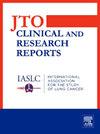新的PLEC-EML4-ALK双融合在转移性炎症性肌纤维母细胞肿瘤中的克唑替尼耐药性:1例报告
IF 3.5
Q2 ONCOLOGY
引用次数: 0
摘要
ALK融合是炎性肌成纤维细胞肿瘤中常见的致癌驱动因素。克唑替尼治疗对融合阳性患者有效;然而,获得性耐药性仍然是一个挑战。在这里,我们报告了一例eml4 - alk阳性转移性炎性肌成纤维细胞肿瘤,最初对克唑替尼有反应,但后来产生了耐药性。进展的病变显示获得了“双融合”事件,其中EML4-ALK被额外融合到PLEC中,以创建PLEC-EML4-ALK转录物。双重融合与ALK表达的增加有关,模拟了ALK融合扩增,这是肺癌中对克唑替尼耐药的已知机制。在过渡到更有效的ALK抑制剂alectinib时,患者表现出戏剧性的反应。因此,双融合的形成代表了对克唑替尼耐药的一种新的和可靶向的机制。本文章由计算机程序翻译,如有差异,请以英文原文为准。
Novel PLEC-EML4-ALK Double Fusion Underlying Crizotinib Resistance in a Metastatic Inflammatory Myofibroblastic Tumor: A Case Report
ALK fusions are frequent oncogenic drivers in inflammatory myofibroblastic tumors. Treatment with crizotinib is effective in fusion-positive patients; however, acquired resistance remains a challenge. Here, we present a case of EML4-ALK-positive metastatic inflammatory myofibroblastic tumor that initially responded to crizotinib but developed resistance. The progressing lesion revealed the acquisition of a “double fusion” event in which EML4-ALK was additionally fused to PLEC to create a PLEC-EML4-ALK transcript. The double fusion was associated with an increase in ALK expression, mimicking the ALK fusion amplification that is a known mechanism of resistance to crizotinib in lung cancer. On transition to the more potent ALK inhibitor alectinib, the patient exhibited a dramatic response. Thus, the formation of a double fusion represents a novel and targetable mechanism of resistance to crizotinib.
求助全文
通过发布文献求助,成功后即可免费获取论文全文。
去求助
来源期刊

JTO Clinical and Research Reports
Medicine-Oncology
CiteScore
4.20
自引率
0.00%
发文量
145
审稿时长
19 weeks
 求助内容:
求助内容: 应助结果提醒方式:
应助结果提醒方式:


